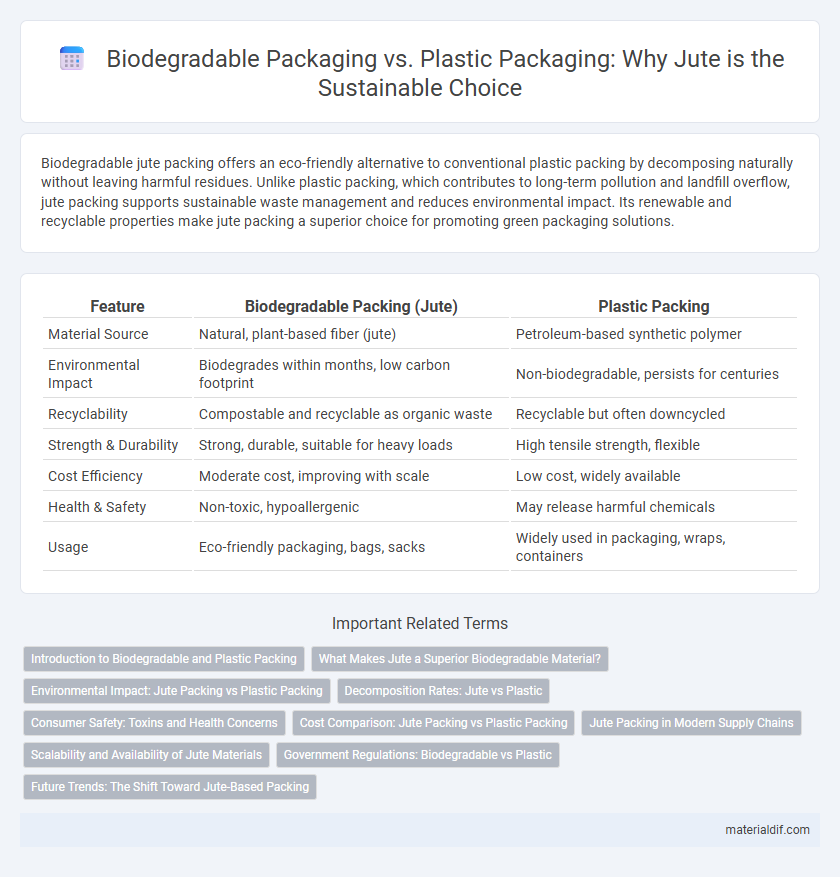Biodegradable jute packing offers an eco-friendly alternative to conventional plastic packing by decomposing naturally without leaving harmful residues. Unlike plastic packing, which contributes to long-term pollution and landfill overflow, jute packing supports sustainable waste management and reduces environmental impact. Its renewable and recyclable properties make jute packing a superior choice for promoting green packaging solutions.
Table of Comparison
| Feature | Biodegradable Packing (Jute) | Plastic Packing |
|---|---|---|
| Material Source | Natural, plant-based fiber (jute) | Petroleum-based synthetic polymer |
| Environmental Impact | Biodegrades within months, low carbon footprint | Non-biodegradable, persists for centuries |
| Recyclability | Compostable and recyclable as organic waste | Recyclable but often downcycled |
| Strength & Durability | Strong, durable, suitable for heavy loads | High tensile strength, flexible |
| Cost Efficiency | Moderate cost, improving with scale | Low cost, widely available |
| Health & Safety | Non-toxic, hypoallergenic | May release harmful chemicals |
| Usage | Eco-friendly packaging, bags, sacks | Widely used in packaging, wraps, containers |
Introduction to Biodegradable and Plastic Packing
Biodegradable packing, made from natural materials like jute, decomposes through biological processes, reducing environmental impact and promoting sustainability. Plastic packing, primarily derived from petrochemicals, resists natural degradation, contributing significantly to pollution and landfill accumulation. Choosing biodegradable packing supports eco-friendly practices by minimizing carbon footprint and promoting waste reduction.
What Makes Jute a Superior Biodegradable Material?
Jute stands out as a superior biodegradable material due to its natural fiber composition, which decomposes rapidly without releasing harmful toxins, unlike plastic that can take centuries to break down. Its high tensile strength and water resistance make jute packaging durable yet eco-friendly, reducing environmental pollution and landfill burdens. Moreover, jute cultivation enhances soil fertility and requires minimal pesticides, further underscoring its sustainability compared to synthetic plastic alternatives.
Environmental Impact: Jute Packing vs Plastic Packing
Jute packing significantly reduces environmental pollution due to its natural biodegradability, decomposing within months without releasing harmful toxins, unlike plastic packing which can persist for hundreds of years and leach toxic chemicals into ecosystems. The carbon footprint of jute production is considerably lower, as it requires minimal synthetic inputs and contributes to soil fertility, while conventional plastic packaging relies heavily on fossil fuels and contributes to greenhouse gas emissions. Choosing jute over plastic mitigates landfill waste accumulation and ocean pollution, supporting sustainable packaging solutions aligned with circular economy principles.
Decomposition Rates: Jute vs Plastic
Jute packaging decomposes naturally within 1 to 3 months, significantly reducing environmental impact compared to plastic packing, which can take up to 500 years to break down. The rapid biodegradation of jute fibers supports soil enrichment and minimizes landfill accumulation. In contrast, plastic's prolonged decomposition contributes to persistent pollution and harmful microplastic formation.
Consumer Safety: Toxins and Health Concerns
Jute packaging offers a natural, toxin-free alternative to plastic packing, significantly reducing the risk of harmful chemical exposure for consumers. Unlike plastic, which can leach dangerous substances such as BPA and phthalates into products, biodegradable jute fibers do not release toxins that compromise health. Choosing jute enhances consumer safety by minimizing exposure to endocrine disruptors linked to chronic illnesses.
Cost Comparison: Jute Packing vs Plastic Packing
Jute packing offers a cost-effective alternative to plastic packing by utilizing a renewable and biodegradable material that reduces environmental cleanup expenses and waste management costs. Although the upfront price of jute bags may be slightly higher than plastic counterparts, long-term savings are realized through durability, reusability, and lower disposal fees. Economically, investing in jute packing aligns with sustainable business practices while mitigating the hidden costs associated with plastic pollution.
Jute Packing in Modern Supply Chains
Jute packing offers a sustainable alternative in modern supply chains due to its biodegradability, reducing environmental pollution compared to conventional plastic packing. Its natural fibers decompose quickly, minimizing landfill accumulation and carbon footprint. The integration of jute packaging supports eco-friendly logistics and aligns with global efforts to decrease plastic waste in supply chain management.
Scalability and Availability of Jute Materials
Jute materials offer significant scalability advantages over plastic packing due to their abundant availability in major producing countries like India and Bangladesh, where annual production exceeds 2 million tons. Biodegradable jute packing supports sustainable supply chains by utilizing renewable resources that decompose naturally within months, unlike plastic alternatives that persist for centuries. The widespread cultivation of jute provides a reliable and cost-effective source for eco-friendly packaging solutions, meeting increasing global demand without depleting finite resources.
Government Regulations: Biodegradable vs Plastic
Government regulations increasingly favor biodegradable packing materials like jute over plastic due to their reduced environmental impact and enhanced sustainability. Policies in regions such as the European Union and India enforce strict bans or taxes on single-use plastic packaging, promoting biodegradable alternatives that comply with circular economy goals. Compliance with these regulations supports businesses in avoiding penalties and aligns with global efforts to reduce plastic pollution and carbon emissions.
Future Trends: The Shift Toward Jute-Based Packing
Jute-based packing is gaining traction as a sustainable alternative to plastic packing due to its biodegradability and renewability, significantly reducing environmental pollution. Innovations in jute processing and composite materials enhance its durability and versatility for various packaging applications. Market forecasts predict a substantial growth in demand for jute-packaging as global regulations tighten against single-use plastics and consumers increasingly prefer eco-friendly products.
Biodegradable Packing vs Plastic Packing Infographic

 materialdif.com
materialdif.com